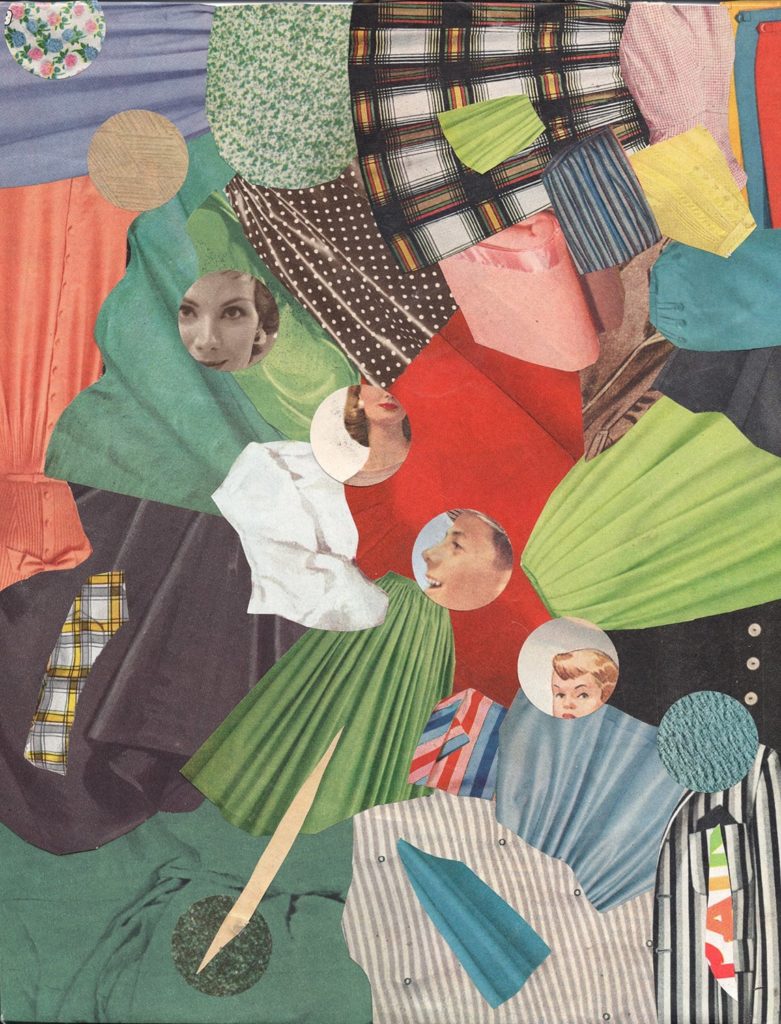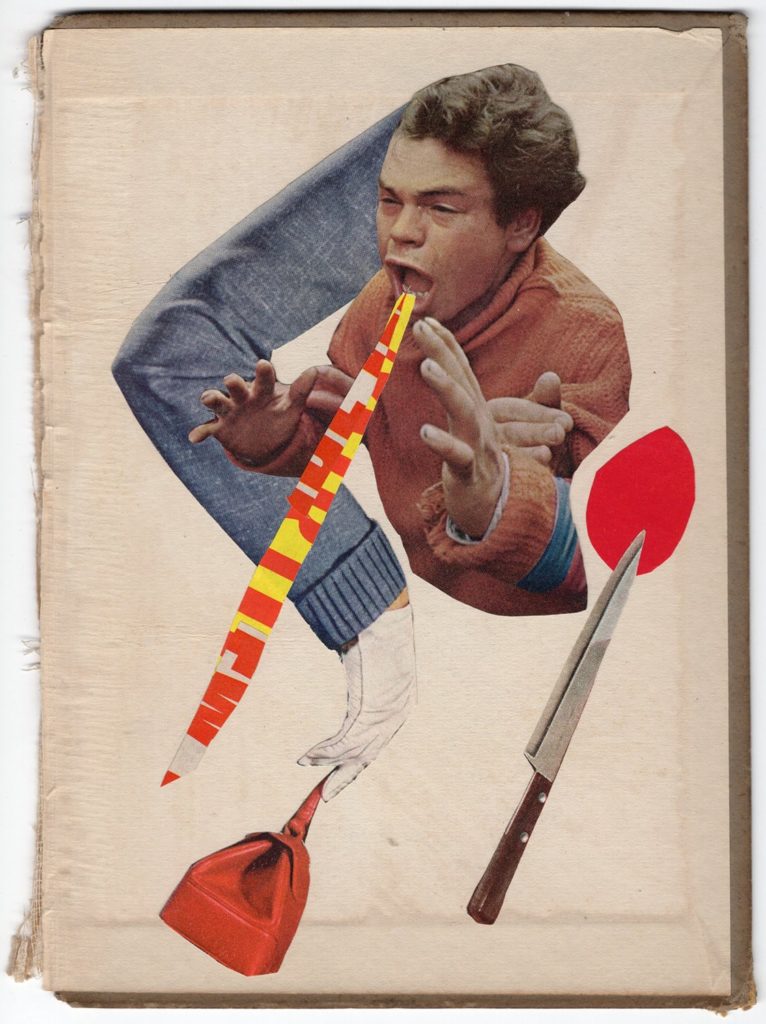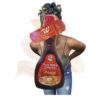Kevin Sampsell is a collage artist, a writer, runs a publishing company and recently co-founded an online collage gallery, Sharp Hands. Andrea Burgay visited Sampsell’s home studio and “Collage Garage” in Portland, OR and they began a conversation about Sampsell’s work and many projects that continues with this interview.

AB: What do you consider to be your first experiences with collage?
KS: I think my first realization of collage as a technique was reading the William S. Burroughs cut-up novels and seeing how it reinvented and rearranged language. It inspired me to do a similar thing — cutting words from newspaper headlines and rearranging them into a random weirdness that made me laugh. This was just a little before Magnetic Poetry was marketed. It’s funny to think that those Magnetic Poetry kits have (perhaps subliminally) introduced millions of people to the concept of language collage.
For a long time, I don’t think I saw image-based collages out in the world as anything different than any other visual art or design. It wasn’t until I started mixing images into my word collages, about seven years ago, that I realized that collage was a wholly unique and universal art form. As I started using less words and more images, it was like the world around me changed and I started to see how collage was actually all over the place — in advertising, on book covers, in the way landscapes look, in fashion, and even the way telephone poles look when concert fliers are stapled all over each other and torn away to reveal the layers.
So, the last seven years have sort of felt like a series of “first experiences” for me with collage because it’s such a vast world of discovery.


AB: Your collage works feel playful, free, and open to exploring different styles and ways of working. Can you tell us about the interests and ideas that inspire you?
KS: Oh, playfulness is definitely a key! It has to be fun for me and part of that fun is to try different approaches and styles. If things start to feel too same-y I’ll lose interest. I need to flip the script. Same thing with the writing I enjoy and the music I listen to. I like surprises and swerves and unexpected turns. So I’m always inspired by what other collage artists are doing and have found myself getting ideas from paintings as well. I sometimes try to sneak paint and other elements into my collages. Humor always inspires me. Seduction inspires me. Finding images that make me wonder about the past inspires me.

Ab: What types of images attract you?
KS: In the collage world, it starts to become easy to recognize and identify certain images. Sometimes it’s from a certain ad or story in an old National Geographic or Life Magazine. I’ve used images from those sources, but I get more excited when I find more obscure images from places like high school yearbooks, outdated instruction books, discarded photos, and stuff like that. The way people look in some of these photos is so unedited, un-photoshopped, and candid — I’m a sucker for faces. Lately, I’ve been hunting for blocks of colors that I can cut into circles and shards. Most of what I use is from older sources because I love the way the colors look kind of washed out and aged, and I rarely connect to anything that looks too glossy or new. I like things that are pretty but I also want there to be something that’s maybe a little unsettling or mysterious.

AB: How do you collect and organize the elements that you use in your work?
KS: There are nights when I just cut things out and put them on a big table and let them pile up without any clear plan or intention. And then I return to those piles later and just have a night where I move things around and start gluing. But I also have a couple of large plastic storage containers and some stackable drawer kind of things that I put them in. I’m fairly tidy and organized, but I sometimes forget to put stuff away. I’ll open up an old knitting magazine and find a bunch of stuff that I cut up and forgot about inside of it.


AB: In your recent series, dense, colorful spaces full of movement are created using cut-out images of clothing and fabric from vintage illustrations. Please tell us more about this series. How did it begin and how do you see it continuing?
KS: A friend of mine gave me a 900-page Montgomery Ward catalog from 1957 and it’s full of clothes! Some of it is shown on wholesome catalog models from that era and some is shown in these charming illustrations that are almost like paintings. I started cutting out just chunks of the clothing and I loved how the folds and textures of the fabrics looked when separated from the consumer aspect of their origins— not to mention the colors! Around this same time I also was gifted a box of old magazines like Collier’s and Look from the 1940s and ’50s. These were publications that published a lot of short stories and dramatic real life accounts that were usually illustrated with noir-like paintings of people in various action poses wearing stylish dresses, trench coats, soldier’s uniforms, and the like. The texture of clothes and fabric in these images is really engaging, even when cut away from the bodies of the characters.
Once I started cutting through these pages with the sole intention of cutting out the most interesting clothes, the pieces accumulated quickly. I bought a couple of 16 x 20 inch wood panels to work on. Most of my collages are smaller, like between 5 x 7 and 11 x 14, and usually have less than ten elements. But I wanted to challenge myself to do something bigger, almost like a multi-color abstract painting, but with paper pretending to be fabric. It’s some of my favorite work that I’ve ever done. It’s something you can look at for a while and try to figure out like puzzle pieces.

AB: In viewing these works, the elements seem to shift between reading as colorful, patterned forms, to becoming the skirts, sleeves and shirts of their source material. How do you think about using recognizable images in your work versus using elements for their color, form or texture?
KS: I like landing somewhere in between recognizable and enigmatic. If I’m using a color that seems like it came from a pack of cigarettes or a can of soda, I want it to feel untethered from its original image. There’s something really funny about that to me — if I can take the yellow color from a can of motor oil and put it somewhere that makes it look elegant in some way. It’s almost like trolling these corporations, the way you can appropriate their colors, images, and brands. Another example of this is something I started doing more and more in the last year or so: I’ll look for text (usually in advertisements) that use interesting fonts and colors and I’ll cut just through the middle part so you can’t quite tell what the letters are or what the word is. They become slivers of indecipherable language. Kind of like when you hear a fuzzy recording of someone and you can’t quite make out what they’re saying.

AB: Can you tell us about your workspace? Does it influence your work in any way?
I’ve been living in the house of my friend and fellow collage artist, Kurtiss Lofstrom, for about five years now. It’s a beautiful home in northeast Portland and we have a nice old barn-style garage in the backyard where we keep our bookshelves of material and various tools and surfaces to work on. We call it “The Collage Garage.” Kurtiss’ work is much bigger than mine and a lot of it is hanging around the house and garage, as well as work and artifacts from many artists and establishments. It’s a feast for the eyeballs for sure. I have art in my own room by a few of my favorite Portland painters like Tia Factor, Emily Kepulis, and Tatyana Ostapenko. There are also zines and books everywhere with collage and other visual art in them.
Sometimes I work in the garage, but when it’s too cold out I just collage in the front room of the house, where there’s a big window feeding the room with natural light. I adopted a beautiful cat named Susan at the beginning of 2020 and she’s also a constant presence and inspiration on the work I do. Or at least she keeps my spirits up!

AB: You are also a writer, editor and publisher, with your own press, Future Tense Books. How do you think your approach to writing differs from your work with collage? Are there similarities in your approaches to both?
KS: My work as a writer and publisher involves more mental process. I always say, at least for me, that writing is all from the brain and my collaging is all from the eyes. It’s like thinking vs seeing. And thinking can be exhausting! Seeing is more fun for me in a lot of ways. But emotionally, I guess I would give the edge to writing. They’re both rewarding to me, but in pretty different ways. There are similarities as far as approach goes. I do see writing as art, and each short story, essay, or poem I write is meant to be experienced as individual pieces of art. And like my collage making, I want my writing to be funny at times, as well as surprising.

AB: A book of your collages and poems will be released in 2022 (I Made an Accident, Clash Books). How do your collages and poems work together? What was the process of creating this book?
KS: I’m really lucky to have a publisher who’s excited to put out a book of my collages AND poetry. I think these first few years of making collages are similar to my early years of writing, which consisted mostly of poems and experiments. I don’t have formal training in either! But of all my writing, I think my poems are the closest thing to collaging. It’s more fragmented and free form in some ways, even when they’re telling a story or trying to make you laugh. The book’s release date got pushed back a little due to COVID but it’s been super fun to go through all these collage files. There will probably be around 200 collages in it, even dating back to some of the early word collages to newer work. The title, I Made an Accident, comes from the fact that some of my more interesting pieces come from weird accidents that I discover in the process. Like when you cut out something and then turn it around and see that the other side is even more strange and engaging than what you were cutting out. Or when you’re done with a night of tearing and cutting through stuff and discover a ready-made collage in your basket of discarded scraps.
AB: Sharp Hands is an exciting new online gallery that you’ve started last year with artist Cheryl Chudyk, featuring several shows each year of new work created specifically for each exhibition. How did this gallery start and what are your goals for the platform?
KS: It all started when I realized that I missed going to galleries and art spaces to see art in person. I wanted to organize something that had the excitement of a group showing where people could see new work presented in a nice way. At first, I thought it could be a page on Facebook or Instagram, but that seem too stilted and contained. I called Cheryl, whom I’d met at Kolaj Fest in 2018, and asked if she wanted to create and run it with me. She’s as excited about the world of collage as I am and she has great taste, amazing energy, and organizational skills. I was so happy when she said she’d do it with me and we started making lists of people whose work we wanted to show. We wanted people from all over the world and with different levels of popularity. We’re excited to have some collage stars like Danielle Krysa and Miss.Printed, but love giving a stage to people we’re just discovering too—like Julian Foster, Mel Lineham, and Feransis.
We feature six new collages by six artists in each show and the styles have been varied and ambitious. We created Sharp Hands to put another spotlight on collage art in a similar way that The Weird Show or The Jealous Curator or Kolaj Magazine does. Collage is often downplayed in the wider art world, so we’re very focused on kicking against the notion that it’s less than other kinds of art. It’s kind of the punk rock of art practices. Anyone can do it and there are no rules. It’s my absolute favorite kind of art. Sometimes when I go into a gallery, I pass by a lot of the paintings, drawings, photographs, or whatever, and go straight for the stuff that looks like it’s been in a knife fight. So Sharp Hands does the same thing—gets right to the exciting weird shit. The best shit. Collage is life. Collage for life.
–
Kevin Sampsell’s upcoming book of collage and poetry, I Made an Accident, will be published by Clash Books in 2022.
Find more about Kevin Sampsell on his website
Visit Sharp Hands Gallery











